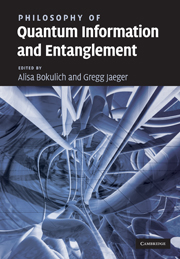Book contents
- Frontmatter
- Contents
- List of contributors
- Preface
- Introduction
- Part I Quantum entanglement and non-locality
- 1 Non-locality beyond quantum mechanics
- 2 Entanglement and subsystems, entanglement beyond subsystems, and all that
- 3 Formalism locality in quantum theory and quantum gravity
- Part II Quantum probability
- Part III Quantum information
- Part IV Quantum communication and computing
- Index
3 - Formalism locality in quantum theory and quantum gravity
from Part I - Quantum entanglement and non-locality
Published online by Cambridge University Press: 04 August 2010
- Frontmatter
- Contents
- List of contributors
- Preface
- Introduction
- Part I Quantum entanglement and non-locality
- 1 Non-locality beyond quantum mechanics
- 2 Entanglement and subsystems, entanglement beyond subsystems, and all that
- 3 Formalism locality in quantum theory and quantum gravity
- Part II Quantum probability
- Part III Quantum information
- Part IV Quantum communication and computing
- Index
Summary
Introduction
Indefinite causal structure poses particular problems for theory formulation since many of the core ideas used in the usual approaches to theory construction depend on having definite causal structure. For example, the notion of a state across space evolving in time requires that we have some definite causal structure so we can define a state on a space-like hypersurface. We will see that many of these problems are mitigated if we are able to formulate the theory in a formalism-local (or F-local) fashion. A formulation of a physical theory is said to be F-local if, in making predictions for any given arbitrary space-time region, we need only refer to mathematical objects pertaining to that region. This is a desirable property both on the grounds of efficiency and since, if we have indefinite causal structure, it is not clear how to select some other space-time region on which our calculations may depend. The usual ways of formulating physical theories (the time-evolving state picture, the histories approach, and the local-equations approach) are not F-local.
We set up a framework for probabilistic theories with indefinite causal structure. This, the causaloid framework, is F-local. We describe how quantum theory can be formulated in the causaloid framework (in an F-local fashion). This provides yet another formulation of quantum theory. This formulation, however, may be particularly relevant to the problem of finding a theory of quantum gravity. The problem of quantum gravity is to find a theory that reduces in appropriate limits to general relativity and quantum theory (including, at least, those situations in which those two theories have been experimentally confirmed).
Information
- Type
- Chapter
- Information
- Philosophy of Quantum Information and Entanglement , pp. 44 - 62Publisher: Cambridge University PressPrint publication year: 2010
Accessibility standard: Unknown
Why this information is here
This section outlines the accessibility features of this content - including support for screen readers, full keyboard navigation and high-contrast display options. This may not be relevant for you.Accessibility Information
- 2
- Cited by
